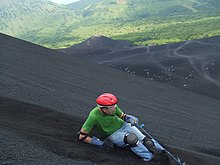
Northern Pacific Coast is a region along the Pacific coast in western Nicaragua. It has beautiful beaches, impressive volcanoes and colonial cities and churches.
Cities
editOther destinations
editBeaches
edit- 1 Miramar, El Velero, Playa Hermosa & El Tránsito- a string of Pacific beaches close to Managua.
- 2 Poneloya & Las Peñitas - two Pacific beach towns near León.
- 3 Aserradores - northern beach with the famous Boom surfing wave.
- 4 Jiquilillo - beach next to the Padre Ramon Nature Reserve.
Nature
edit- 5 Estero Real Nature Reserve - a huge estuary and the home of wild growing corn
- 6 Volcan Cosigüina - which in 1835 had the third largest volcanic eruption in recorded history.
- 7 Cordillera Los Maribios - a chain of impressive volcanoes, many active. On Cerro Negro you can do Volcano surfing.
- 8 San Jacinto hot springs.
History
edit- 9 León Viejo - the ruins of old León, destroyed by a volcano eruption in 1610. Now an UNESCO world heritage site.
Understand
editThe Northern Pacific Coast of Nicaragua consists of the departments of Chinandega and León with an approximate population of 865,000 (2020). Along the Pacific coast, there are many beaches and estuaries. A chain of active volcanoes, the Cordillera Los Maribios, cuts through the region.
The two major cities are León and Chinandega, Nicaragua's second and fourth largest cities respectively. León, a colonial city founded in 1524, is the country's intellectual center with the oldest and largest cathedral, the oldest university and many museums. Chinandega is a commercial and agricultural hub. Corinto has Nicaragua's biggest port.
The region is a major agricultural producer. Important crops include sugar cane, rice, soy, corn, beans, bananas, peanuts and sesame seeds. There are fishing villages, shrimp farms and salt producers along the coast.
Talk
editSpanish
Get in
edit
- Internationally by air through Managua Airport or by land from Honduras.
- From Managua by bus, car or taxi.
- From the Northern Highlands by bus or car.
- From Honduras via the border crossing at Guasaule.
- From El Salvador by boat from La Union to Potosí.
Get around
editSee
editDo
edit
- Hike up Volcan Cosigüina or one of the many volcanoes in the Cordillera Los Maribios.
- Surf down Volcan Cerro Negro.
- Swim or surf the Pacific beaches in Poneloya, Las Peñitas, Aserradores or Jiquilillo.
- Kayak in the Juan Venado, Padre Ramos or Estero Real Nature Reserves.
- Enjoy the hot springs in San Jacinto.
Drink
editTemperatures can rise well above 35°C (100°F) during the dry season (December - April), so make sure to stay hydrated. Although some say that tab-water in León is safe, stick to bottled water, delicious juices, beer or the local Flor de Caña (Nicaraguan rum).
Stay safe
editPacific coast currents can be very strong and dangerous even for trained swimmers in their best health. Don't go too far out, stay on official beaches, don't go too far out and follow any warning signs. Weaker swimmers may prefer to enjoy the estuaries with their calmer waters.
Go next
edit- Northern Highlands for cooler temperatures.
- Southern Pacific Coast for more beaches and more surfing.
- Granada to check out the historical rival of León.
- Honduras



